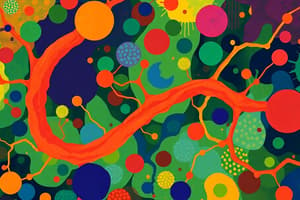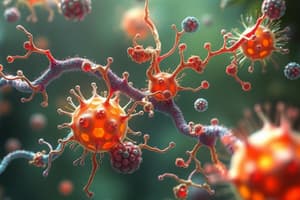Podcast
Questions and Answers
What is the resulting molecule from the decarboxylation of pyruvate?
What is the resulting molecule from the decarboxylation of pyruvate?
- Pyruvate
- Acetyl group (correct)
- Glucose
- NADH
What is the byproduct of glycolysis that yields energy?
What is the byproduct of glycolysis that yields energy?
- FADH₂
- NADH
- 2 ATP (correct)
- Acetyl group
What is the role of NAD+ in glycolysis?
What is the role of NAD+ in glycolysis?
- Electron donor
- Electron acceptor (correct)
- Carrier compound
- Energy source
What is the final electron acceptor in aerobic respiration?
What is the final electron acceptor in aerobic respiration?
Where do electron transfers take place in eukaryotic cells?
Where do electron transfers take place in eukaryotic cells?
How many ATP molecules are produced during anaerobic respiration?
How many ATP molecules are produced during anaerobic respiration?
What is the purpose of fermentation?
What is the purpose of fermentation?
How many ATP molecules are produced during glycolysis?
How many ATP molecules are produced during glycolysis?
What is the primary role of enzymes in biochemical reactions?
What is the primary role of enzymes in biochemical reactions?
What is the effect of increasing the amount of enzyme or substrate on a biochemical reaction?
What is the effect of increasing the amount of enzyme or substrate on a biochemical reaction?
What is the function of cofactors in enzyme activity?
What is the function of cofactors in enzyme activity?
What is the effect of inhibitors on enzyme activity?
What is the effect of inhibitors on enzyme activity?
What is the primary source of organic molecules for heterotrophs?
What is the primary source of organic molecules for heterotrophs?
What is the source of energy for chemoautotrophs?
What is the source of energy for chemoautotrophs?
What type of organisms convert solar energy into chemical energy?
What type of organisms convert solar energy into chemical energy?
What is the primary source of chemical energy for heterotrophic organisms?
What is the primary source of chemical energy for heterotrophic organisms?
What is the purpose of phospholipases in microbial degradation?
What is the purpose of phospholipases in microbial degradation?
What is the result of catabolic pathways for lipids and proteins?
What is the result of catabolic pathways for lipids and proteins?
What is the role of extracellular lipases in microbial degradation?
What is the role of extracellular lipases in microbial degradation?
What is the significance of microbial photosynthesis?
What is the significance of microbial photosynthesis?
What are the six most common elements associated with organic molecules?
What are the six most common elements associated with organic molecules?
What is the direction of energy flow in ecosystems?
What is the direction of energy flow in ecosystems?
What is the primary function of microbial metabolism?
What is the primary function of microbial metabolism?
What is anabolic reaction?
What is anabolic reaction?
What is the purpose of exergonic reactions?
What is the purpose of exergonic reactions?
What is the result of glycolysis?
What is the result of glycolysis?
What is the difference between respiration and fermentation?
What is the difference between respiration and fermentation?
What is the role of enzymes in metabolic pathways?
What is the role of enzymes in metabolic pathways?
What is the relationship between catabolic and anabolic reactions?
What is the relationship between catabolic and anabolic reactions?
What is the result of catabolic reactions?
What is the result of catabolic reactions?
Flashcards are hidden until you start studying
Study Notes
Microbial Metabolism
- Microbial metabolism is a complex system of interwoven pathways coordinated by an intricate, multilayered regulatory network.
- Microbes use various metabolic strategies to obtain energy and nutrients required for viability and reproduction.
- There are two types of metabolic reactions: catabolic and anabolic reactions.
Metabolic Pathways
- Cellular processes, such as building or breaking down complex molecules, occur through series of stepwise, interconnected chemical reactions called metabolic pathways.
- Anabolism refers to endergonic metabolic pathways involved in biosynthesis, converting simple molecular building blocks into more complex molecules, and fueled by the use of cellular energy.
Energy and ATP
- Energy is required to fuel anabolic reactions.
- Exergonic reactions provide energy for endergonic reactions.
- ATP is produced through cellular respiration and fermentation.
Fermentation
- Fermentation is a metabolic process that produces ATP with a low ATP yield.
- Fermentation uses an organic molecule as a final electron acceptor to regenerate NAD⁺ from NADH.
- Fermentation does not involve an electron transport system, and no ATP is made by the fermentation process directly.
Respiration
- Respiration is a metabolic process that produces ATP with a high ATP yield.
- Cellular respiration begins when electrons are transferred from NADH and FADH₂ to a final inorganic electron acceptor (either oxygen in aerobic respiration or non-oxygen inorganic molecules in anaerobic respiration).
Glycolysis
- Glycolysis is the first step in the breakdown of glucose, resulting in the formation of ATP, NADH, and two pyruvate molecules.
- Glycolysis catalyzes the conversion of glucose to pyruvic acid (pyruvate).
- Glycolysis releases energy to yield 2 ATP per glucose and transfers high-energy electrons (+H) to NAD⁺ to yield 2 NADH.
Catabolism of Carbohydrates, Lipids, and Proteins
- Catabolic pathways for carbohydrates, lipids, and proteins eventually connect into glycolysis and the Krebs cycle.
- Microbes can degrade a wide variety of carbon sources, including lipids and proteins.
Photosynthesis and the Importance of Light
- Photosynthesis is the biochemical process by which phototrophic organisms convert solar energy (sunlight) into chemical energy.
- Microbial photosynthesis is a significant supplier of chemical energy, fueling many diverse ecosystems.
Biogeochemical Cycles
- Energy flows directionally through ecosystems, entering as sunlight for phototrophs or as inorganic molecules for chemoautotrophs.
- The six most common elements associated with organic molecules (carbon, hydrogen, nitrogen, oxygen, phosphorus, and sulfur) take a variety of chemical forms and may exist for long periods in the atmosphere, on land, in water, or beneath earth's surface.
Enzymes
- Almost all biochemical reactions are catalyzed by a specific enzyme: proteins that accelerate the rate of a reaction without being changed themselves.
- Enzymes lower the activation energy (Ea) and provide a way to control or regulate biochemical reactions.
Control of Enzyme Activity
- Biochemical reactions can be controlled by changes in enzyme activity, which can be influenced by:
- Changes in the amount of enzyme or substrate.
- Changes in temperature, pH, or salt.
- Availability of any necessary cofactors.
- Effect of inhibitors.
Principles of Energy Generation
- All organisms depend on autotrophs, which can produce organic molecules from CO2, an inorganic carbon source.
- The source of energy for autotrophic processes can be:
- Light: photoautotrophs that carry out photosynthesis.
- Chemical: chemoautotrophs that use various molecules as a source of high-energy electrons.
Studying That Suits You
Use AI to generate personalized quizzes and flashcards to suit your learning preferences.




